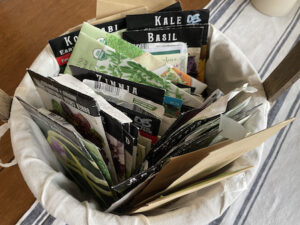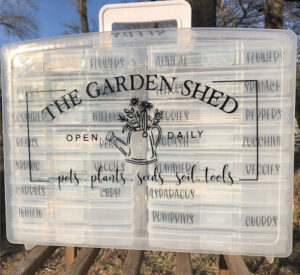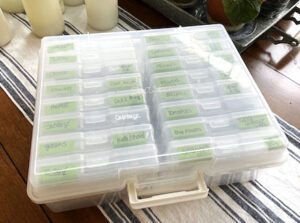Organizing and Storing Your Garden Seeds
by Janet Scheren, Fairfax Master Gardener
 I began with buying a few packs of seeds one year. Then I found out how much I liked growing flowers and veggies from seed — and for a few good reasons: Some plants just grow better from seed directly planted in the ground. It’s nice to have seedlings when I need them, not just when they’re available at the garden center. And it’s useful to try a few varieties of the same plant to see which I like best and which is more productive in my garden. It didn’t take long for a dozen seed packets to grow to well over 100. Before I knew it, I had seeds stashed all over my house in baskets, bins and garden trugs. Clearly this was unworkable.
I began with buying a few packs of seeds one year. Then I found out how much I liked growing flowers and veggies from seed — and for a few good reasons: Some plants just grow better from seed directly planted in the ground. It’s nice to have seedlings when I need them, not just when they’re available at the garden center. And it’s useful to try a few varieties of the same plant to see which I like best and which is more productive in my garden. It didn’t take long for a dozen seed packets to grow to well over 100. Before I knew it, I had seeds stashed all over my house in baskets, bins and garden trugs. Clearly this was unworkable.
While there are cute bins and baskets you can find online for storing smaller quantities of seeds, these don’t work well for larger quantities. You pretty much need a filing system. The best organizing system I’ve found for seeds is actually a photo storage case with sixteen 4 x 6-inch photo boxes, each of which can hold about a dozen packs of smaller seeds — or fewer for larger seeds like beans. This totals to almost 200 seed packs in a neat easy to organize and store container. I wound up buying two of these and keep most of my warm season seeds in one and store seeds for the cooler fall/winter garden in the other. Both Amazon and Michaels sell this type of photo storage box. I found the “fancy” one on Etsy.

Pre-decorated seed storage
While you can get fancy with labeling the boxes, I found that neat printing on green painters’ tape is just fine for me. I actually like the hand lettered look, but I know that others might want to use a labeling system or print out designed labels using their computers. Go for it! You might also want to add special lettering or a design to the outer case itself. In fact, I found a few of these cases on Etsy that offer the selection of gardening motifs already applied to the outer case and boxes. As for the frog tape, as it’s affectionally called, it’s also great for resealing seed packs that don’t come with resealable gummy fold over tabs. That way you won’t have loose seeds in the boxes or larger container.
With my cases in hand, I began to think about how to organize my seeds. I found that it varied from plant to plant and how many of each type of seeds I had and needed to store. For example, I had so many types of lettuce, I wound up dividing between head lettuces and leaf lettuces. I could have also sorted by green lettuces and red or purple varieties with their added anthocyanins. I had so many types of dill that they needed their own storage box, while chervil, thyme and parsley are all housed together in a herbs box in my cool season case. I had so many varieties of basil that they got their own box in the warm season container, while lemongrass, lemon balm, and marjoram were housed together. I had enough room for most of my brassicas to hang out together in one box — broccoli, purple sprouting broccoli, several varieties of cauliflower and even radicchio. But I had too many types of cabbage. They needed their own box. So just see what makes sense to you as you begin to sort your seeds in logical groupings. Cold weather flowers, such as borage, calendula and snap dragons live in my cold season case, while marigolds and zinnias house with my warm season seeds. And I have so many kinds of blue flowers that they all get grouped together.

Photo box for seed storage
I found the need to apply two additional filters to my seed organization system: direct seed vs. transplant and purchase/expiration date. For these parameters, I decided to put stickers or labels on the seed packs themselves. The seed packs will tell you which prefer to be direct sown vs transplanted. For example, most squashes do best sown directly in the soil. And you start them all about the same time each year — after the last frost date. So that’s a detail that can be noted on the seed packet or the seed box. For purchase date, I have decided to note the year of purchase on a small white label on the seed pack itself.
Seed Expiration Dates
While all seed packs suggest you use the seeds for the year they are packaged, most are viable to some extent for three to four years past that date. The date represents when they are freshest, and most likely to germinate at their listed germination rate. As such, it provides the percentage of seeds that successfully sprouted during trials at the seed company. The germination rate will decline some in successive years, so just plant more seeds in each hole or pot to compensate. Unfortunately, seeds for a few crops like parsley, parsnip and alliums (onions, leeks, etc.) are among the short lived. You’ll need to use these up more quickly. Beans, brassicas, squash and melons are among the longer storing seeds, lasting up to five or six years.
Ideal Conditions for Storing Seeds
While the temperature range of 32 to 41 F is ideal for long-term storage, it isn’t critical. Any cool, dry location is suitable for storing seeds. Consistency of temperature and dry conditions are the critical factors. A north facing room is great. Just keep them out of direct sunlight. House temperatures that range from the 60s into the 70s is fine. More important is avoiding spikes of humidity, high-humidity levels or spikes in temperature. That’s why storing them in a garage or outdoor potting shed is not recommended.
Resources
How Long Do Seeds Last?, Petra Page-Mann, Cornell College of Agriculture and Life Sciences
How Long Do Seeds Last and Are They Still Good?, Marie Iannotti, Master Gardener, The Spruce